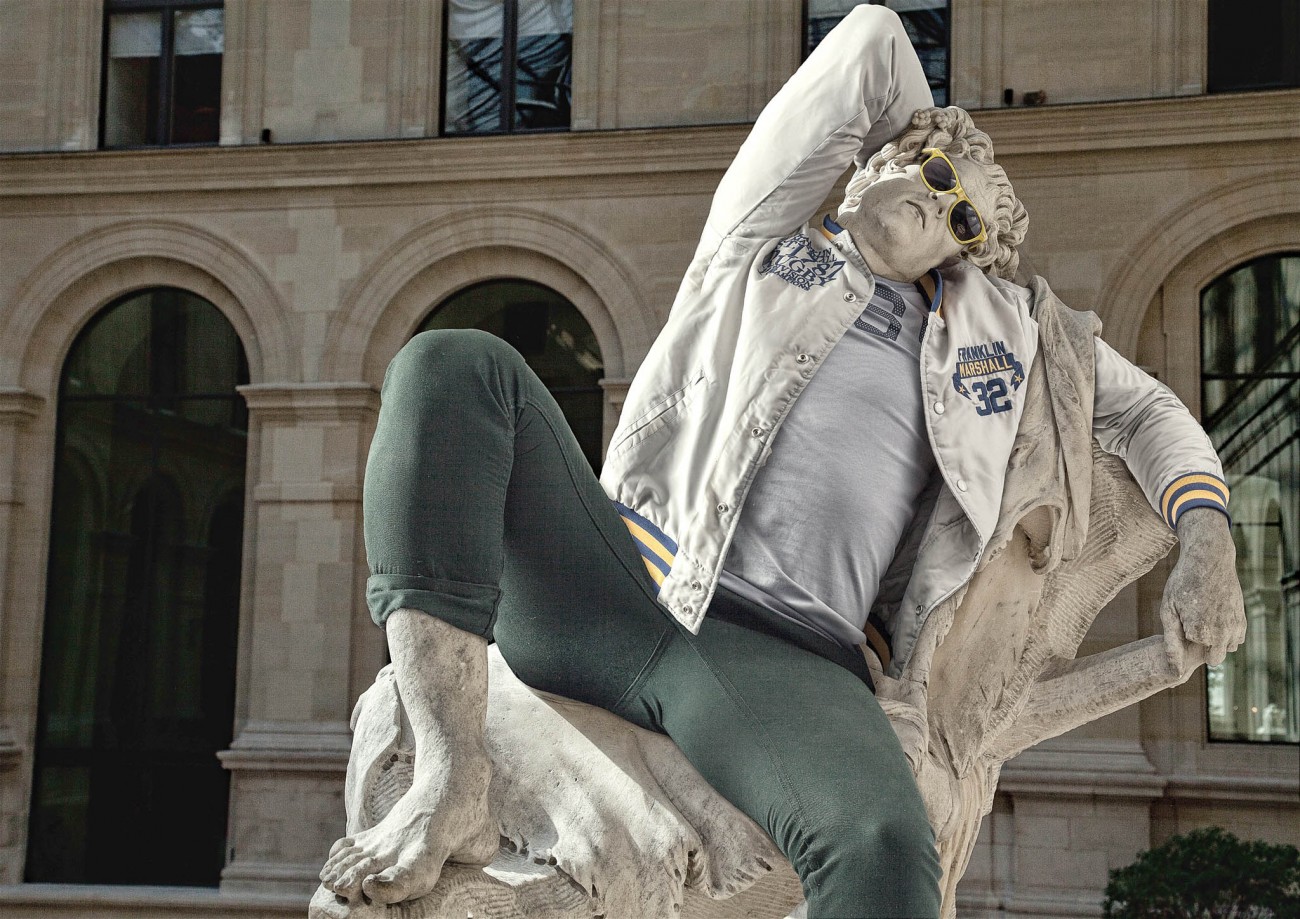Visitors passing through the Museum Entrance Hall at the Getty Center on their way to the galleries may be caught by surprise by a striking figure newly installed on their route: a six-foot-tall marble Sleeping Faun.
This statue, a copy after an ancient marble called the Barberini Faun, was executed by French sculptor and draftsman Edme Bouchardon (1698–1762). The Getty Museum’s major retrospective exhibition on this artist—Bouchardon: Royal Artist of the Enlightenment—will be on view from January 10 to April 2, 2017.
The installation of this masterpiece before the show opens provides visitors with the chance to enjoy one of its highlights during the holiday season. And the pattern of the travertine tiles in the Entrance Hall looks like the space was just calling for this statue to move in!

The Sleeping Faun before and after installation in the J. Paul Getty Museum entrance hall.
But what is the story of this Sleeping Faun, languishing comfortably, apparently undisturbed by the world around him?
After winning the competition of the Royal Academy of Painting and Sculpture in Paris in 1723, twenty-five-year-old Bouchardon was granted a sojourn at the French Academy in Rome to perfect his artistic training. Like all artists of his day, he did this by studying and copying classical art and the great Italian masters. According to the regulations of this royal institution, sculptors were required to make a copy of a classical statue for the French king during their stay. The young Bouchardon worked on his copy after the Barberini Faun for four years, from 1726 to 1730, in an atelier on the ground floor of the Mancini Palace, where the French Academy was installed (today it is in the Villa Medici).

Vue de l’Académie Royale de Peinture &c. à Rome, 1761. The Getty Research Institute, Los Angeles. Digital image courtesy of the Getty’s Open Content Program.
A famous antique masterpiece, the Barberini Faun was found in the 1620s in Rome, thanks to excavations undertaken by Pope Urban VIII to work on the fortifications of the Castel Sant’Angelo. The pointed ears and long tail of this male figure identified it as a faun, a mythological creature that is half-human, half-goat. The sculpture belonged to the pope’s nephew, Cardinal Francesco Barberini, and was kept in the Barberini Palace in Rome until the end of the eighteenth century. Bought by Prince Ludwig of Bavaria in 1814, it was placed in the Munich Glyptothek, where it is still on view today.

Barberini Faun, ca. 220 B.C., Greek or Roman. Staatliche Antikensammlungen und Glyptothek, Munich. Photo: Carole Raddato, licensed under a Creative Commons Attribution-ShareAlike 2.0 license. Source: Wikimedia Commons
Originally missing part of its base, the lower portion of the right leg, and the left arm, the antique Barberini Faun was altered over time by restorations.
When Bouchardon copied it in the Barberini Palace, the artwork still had a restoration that had been added in 1679, which included an ornate
support, with the bent right leg in a more upright position. This appearance is recorded in an engraved plate in a 1704 book devoted to famous statues in Rome, a copy of which is conserved in the Getty Research Institute and is available online.

Barberini Faun. Engraving in Raccolta di statue antiche e moderne… (Rome: Gaetano Zenobj, 1704). The Getty Research Institute, 93-B5694, pl. 94
Bouchardon’s Sleeping Faun was greatly admired in his time. An article in a 1732 paper mentions it, declaring that “this copy has even more integrity, purpose, and character than the original.” For the artist’s friend and biographer, the comte de Caylus, “this life-size statue deserves the esteem of artists and connoisseurs. It in no way feels like a copy.”
In 1753, King Louis XV gave the Sleeping Faun to the Marquis de Marigny, director of the Office of Royal Buildings and brother of the king’s mistress Madame de Pompadour, for his gardens at Monceau (a neighborhood in northwest Paris), where it stayed until the French Revolution. During the nineteenth century, the statue decorated the gardens of the Saint-Cloud castle and then the Luxembourg Park in Paris. It entered the Louvre in 1892. And it is thanks to the generosity of the Musée du Louvre, our partner for the show, that this masterpiece could travel to Los Angeles.
Bouchardon’s marble piece shows a generally soft treatment of the flesh, although the surface has been damaged by long outdoor exposure. The torso muscles are subtly rendered beneath a thick skin, which folds naturally on the belly and between the neck and shoulder. The graceful, sleepy face is framed by meticulously chiseled curls.
The sculptor played with a wide variety of surface treatments for the decorative elements of the support—often outlined by deep drill holes creating a contrast with the smooth flesh of the body and enhancing its nudity. While preserving the beauty of the classical original, Bouchardon made the Faun more naturalistic and sensual.

Details of support and leg of The Sleeping Faun
Today, artists still take inspiration from the Barberini Faun and Bouchardon’s Sleeping Faun. Jeff Koons created his Gazing Ball by adding a blue ball on the knee of the figure in a plaster cast after the antique statue. French photographer Léo Caillard had Bouchardon’s Sleeping Faun virtually clothed using digital technology in his series “Hipsters in Stone,” which reimagines centuries-old art in modern attire.
As one of the co-curators of the upcoming exhibition, I am delighted with this special display in the Entrance Hall and I look forward to seeing our visitors’ own reactions to the Faun, including their creative photos of him in this unique location!

Barberini Faun from the series Hipsters in Stone, 2012–16, Léo Caillard. Photographic print. Courtesy of and © Leo Caillard, used with permission





Comments on this post are now closed.